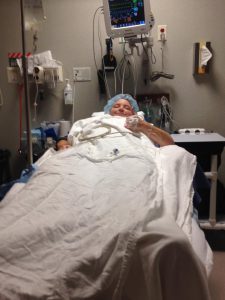By Angelina Labonne
Managing Editor
angelina.labonne5022@mb.rctc.edu

Rachel Javes underwent autologous chondrocyte implantation surgery to replace cartilage in her knee. (Photo courtesy of Rachel Javes)
Every athlete can testify that getting injured is part of the risk that we take every day when we step out onto the field, go up to the mound, or take our stance in our blocks.
As young athletes, we are taught to rise above injury and use them to make us wiser and stronger. However, no coach or overenthusiastic fan will ever sit you down and consider your future and the future state of your body.
Most athletes can testify to the fact that we rarely think about things such as osteoarthritis or cartilage damage. We are absorbed in our sport and dedicated to the cause, giving little thought to the aftermath of our decisions.
That willingness to keep going and push through is what has landed Dr. Aaron Krych’s patient, Rachel Javes, in his office over the last several months. Javes is 33 now and travels to the Mayo Clinic after several failed attempts at other hospitals to restore her knee and alleviate her pain. She was raised in Fridley, Minnesota, where she played basketball, volleyball, and softball throughout high school and softball after high school for a bar league.
Javes was an exceptional softball player not only for her talent but also for her love of the game, and despite her family history of osteoarthritis and many ACL tears along with other knee injuries, she continued to be an athlete.
She is now in need of what is called autologous chondrocyte implantation surgery. ACI surgery is used to manage severe cartilage loss in the knee, and according to Dr. Krych, Jave’s knee was just about as severe as he has ever seen.
Restoration of such a damaged knee happens in two steps. The first step entails removing articular cartilage from a non-weight bearing section of the leg. This cartilage is then shipped, under sterile conditions, for growth in Massachusetts. After the cartilage is cultured and big enough to be put in the damaged patient’s knee, it is cryopreserved by freezing with liquid nitrogen in order to preserve the newly grown cartilage for up to 24 months. The second step in the restoration process involves removing the damaged cartilage from the knee joint and replacing it with the new cartilage that has just been grown. The newly inserted cartilage is as fragile as a blister and must harden over the course of nine to 12 months.
Dr. Krych stressed the holistic aspect of the ACI implantation where the knee and the patient must become equally as important.
“The way we must approach the situation is that there are certain factors, there are patient factors meaning what is the patient activity demand after the surgery, what are their expectations, what are their current symptoms, and how willing are they to undergo extended rehabilitation. Secondly, there are knee factors.”
Dr. Krych uses a pothole analogy to explain these factors.
“If the road is sound and we just have one pot hole to fill, then we have a good candidate for cartilage restoration. However when the road becomes more pothole than road, we can fill them all day, but new ones will always pop up and that is more arthritis than cartilage replacement.”
Dr. Krych and his team look at each patient closely to make sure they are prepared for such an intensive surgery.
“Each patient’s journey is unique. There is a lot of psychology and mental preparation. Their knee and motivation need to both be a candidate for surgery,” he said. “We try to constantly reassure them because we have walked this journey many times before.”
His dedication to detail and repetition of this surgery, about 100 a year, no doubt contributes to the 87 percent to 90 percent success rate of the surgery, with 70 percent of those patients able to return to sports.
Dr. Krych had advice for college athletes who push themselves too far for the love of the game.
“Don’t ignore pain and swelling,” he said. “It is not normal in any circumstance. This may be a sign of cartilage damage, which will not heal on its own due to the lack of blood supply.”
It is important to realize that the ACI patient population is mostly young active adults who have worn their knees too thin and that we can prevent this by simply listening to our bodies and knowing when to back off. Remember athletes and diligent gym goers alike, what may be a small action now of preserving your body can lead to a substantial benefit in the future.
Javes said that the pain is lessening, and she is optimistic about her future. Her goal is to live the next 15 years virtually pain free after this operation and be able to continue her work as a surgical technician on her feet all day.
As far as sports go, now she is more of a viewer than a doer.
“Even when it looks like there is no light at the end of the tunnel, keep fighting and keep believing. In the end, that light is really bright,” Javes said.
